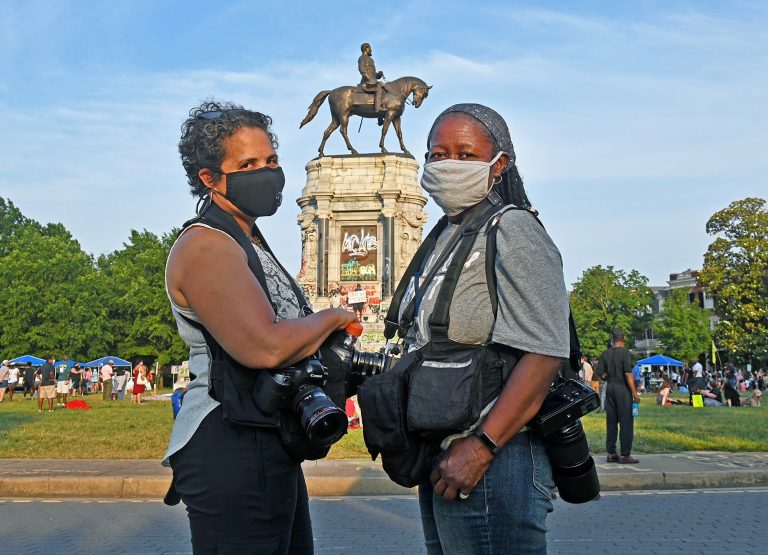Protest images by Richmond Free Press photojournalists remain at Branch Museum until Sept.11.
“(Re)Framing Protest: Design + Hope” at the Branch Museum reminds us that space, regardless of how protected, ornate, or planned, belongs to the people.
During the summer of 2020, it was the people who enlivened space by gathering on Monument Avenue to occupy the historic boulevard and, more importantly, redefine community. In illuminating a broader conversation, protesters showed a need to reclaim public spaces as places of human connection and political resistance.
For 65 consecutive days that summer, Richmond Free Press photojournalists Regina H. Boone and Sandra Sellars used their cameras to document the citywide response to the murders of not just George Floyd and Breonna Taylor, but to all Black victims of police brutality. Using posters, murals, graffiti, and performance, the base of the Lee statue took on a new identity as an open canvas. Through messages and imagery castigating slavery and systematic racism, protesters used new symbols and creative ideas to take the focus off the historic statues and place it onto bigger, more important issues.
“What resonated most with me during the Summer of 2020 was the pure outrage. That was unlike any other protest I’d ever seen through my lens in my many years as a photojournalist, or even as an individual,” recalls Boone, who began her career in 1996 at the Richmond Free Press working for her parents, Raymond and Jean Boone, who had founded the weekly newspaper four years earlier. “The energy was different. The mission was sadly the same, but people were clear they were not backing down.”
The photographs that make up the “(Re)Framing Protest” document small and large moments: The shared experience of a drum circle around the Lee statue. Adults and children working together to create protest signs. The monument base as background for a new graduate wearing cap and gown; or as a dance performance space. In one particularly moving image, a father holds his pink-clad toddler daughter as he teaches her how to make a fist and raise it up, an early lesson in solidarity.
The biggest challenge for Boone and Sellars was trying to stay safe among crowds, often unmasked, in the pre-vaccination era. Just trying to keep up with everything that was unfolding was also a hurdle, but fatigue and adrenaline kept them both pushing forward.
Knowing how important the moment in time was and that their lenses needed to capture as much as possible, they were determined to tell their own story rather than have others try to do it for them. “Being a Black woman photojournalist, along with my colleague Sandra Sellars, put added responsibility on us as members of the Black press,” says Boone. “We did do this for our ancestors and for the future, to clearly see from a Black perspective what we saw on the streets of Richmond in 2020. We understand.”
Activists, artists, and designers ensured that the eyes of the world were on Monument Avenue, and they’re the people who fill the images. Through sheer numbers and collective persistence, they not only reminded the community of the power of everyday people and protest, but their art and design made it impossible to look away.
The exhibition looks at how, both strategically and organically created works -graffiti art, graphic design, and performance, gave voice to traumatic social unrest while at the same time became a transformative blueprint for community building, even healing.
“There was so much art that it began to blow my mind. But really, just seeing the pedestal of the Robert E. Lee monument evolve from that 60-foot roadblock and symbol of hatred into a colorful piece of artwork that celebrated Black lives was most impressive and impactful to me,” Boone explains. “Every day it changed, and every day I lifted my camera to capture the changes as best as I could.”
Community engagement is central to the exhibition. Visitors can respond directly to the photographs and creative work captured by Boone and Sellars by leaving signed or anonymous responses that recall their view of what “we saw.” They’re also invited to step back, reflect, and share in writing what “I see” now, as the city moves forward. Current comments range from “God bless America” to “I saw people standing up until change happened. There is hope for community that celebrates diversity.”
Perhaps some of the highest praise comes from longtime Richmond Times Dispatch photographer Bob Brown, who, after viewing the exhibit, filled out a card stating, “I covered these events for the RTD and shot many photos, but this show by two super-talented photographers captured more than I ever did.”
This again, points to the fact that Boone and Sellars felt personally compelled to document these defining moments; capturing musicians, painters, singers, graphic art designers, print makers, light projection artists, photographers, dancers and more.
“I saw how pain and trauma drove people to be very intentional about how they fought against the injustices of our society -racism, police violence, anti-Black trans- by using their skills as artists to convey their messages in peaceful and extremely creative ways,” Boone says. “We witnessed all hues of people banning together trying their best to right the wrongs that oozed and continue to ooze in our society.”
“(Re)Framing Protest: Design + Hope” through Sept. 11 at the Branch Museum of Architecture and Design, 2501 Monument Avenue, branchmuseum.org
